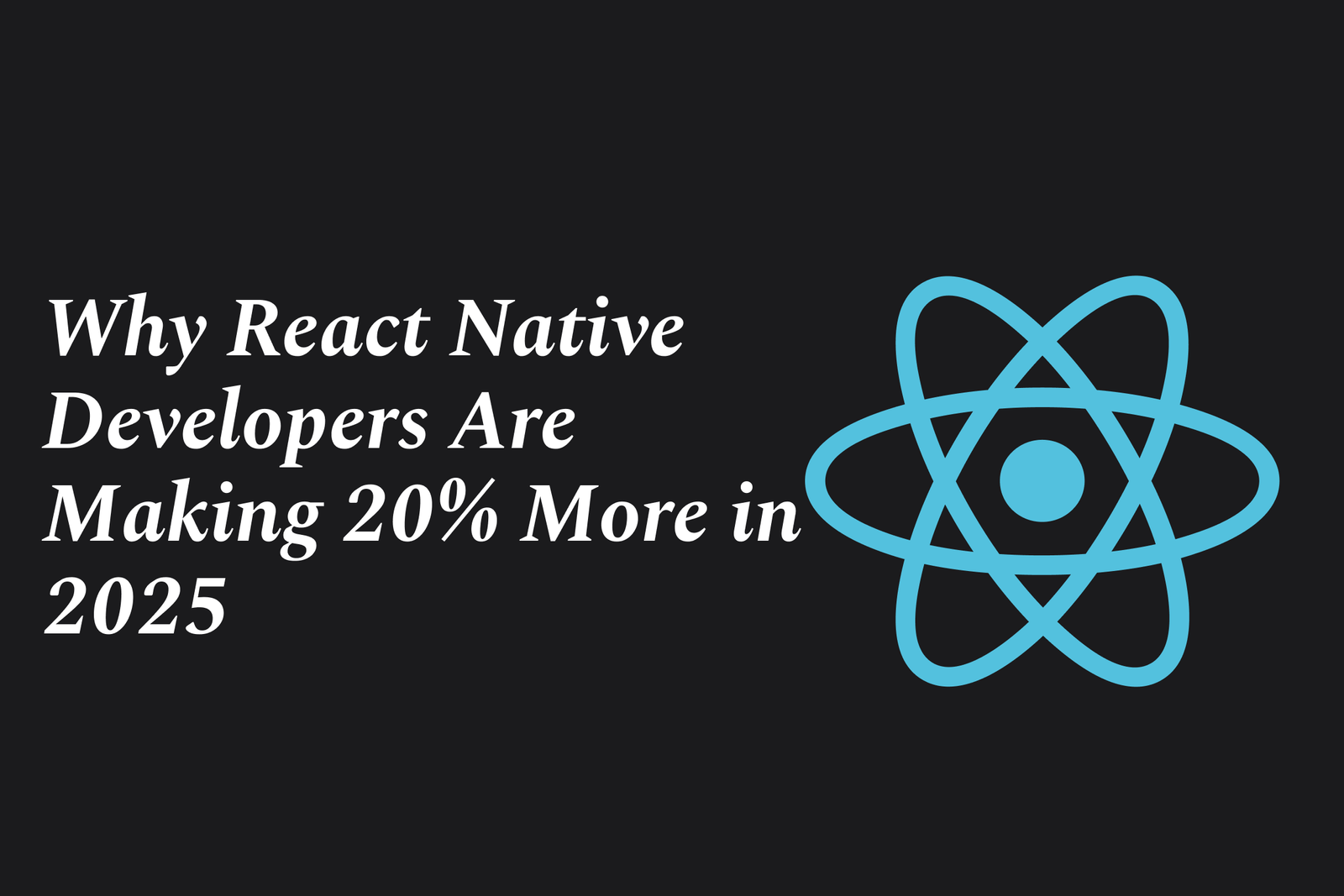Why React native developers are making 20% more in 2025
React Native developers are earning 20% more in 2025 due to soaring demand for efficient cross-platform apps, mastery of evolving tools, and the framework’s cost-saving benefits. Their skills enable faster, high-quality apps across industries, boosting their market value and salary.
Why React Native Developers Are Making 20% More in 2025
1 ) Rising Demand for React Native Skills
React Native’s flexibility and efficiency in cross platform mobile app development have made it a highly sought after skill.
Businesses increasingly prioritize mobile apps due to the surging mobile revenue forecast (over $935 billion by 2024 ), driving demand for developers who can deliver cost effective, performant apps.
React Native developers are uniquely positioned to build apps for both iOS and Android quickly, making their expertise more valuable.
2 ) Cost Effectiveness and Productivity Gains
React Native reduces the need for separate codebases for Android and iOS, significantly lowering development time and maintenance costs.
Companies appreciate the cost efficiency of React Native apps without sacrificing native like usability, making related skills premium.
Developers who can navigate the framework and optimize apps efficiently command higher pay reflecting their contribution to business savings.
3 ) Complexity of New Architectures and Tooling
Despite React Native’s growth, developers face challenges managing evolving architectures and tooling such as the new React Native architecture, debugger tools, and platform inconsistencies.
Mastery over these complexities differentiates skilled developers, justifying increased compensation.
The adoption of automated build solutions like Expo’s EAS Build by 71% reflects a move towards advanced tools, which developers proficient in commanding these tools profit from.
4 ) Versatility Across Industries and Application Scales
React Native is used across diverse sectors including finance, education, and entertainment, as well as in both small (under 1,000 users) and large scale apps (over 100,000 users).
This versatility means developers who specialize in React Native can find opportunities in varied markets and domains, increasing their bargaining power and salary prospects.
5 ) Cross Platform Advantage and Ecosystem Growth
React Native developers benefit from a strong ecosystem, access to frequently updated libraries, and active community support.
The ability to integrate and extend native modules (Camera API, Notifications, Permissions) in cross platform apps adds to their technical value.
With over 80% of respondents focusing on iOS and Android, plus growing web support, React Native skills remain essential and profitable.
6 ) Comparison with Competing Technologies
Alternatives like Flutter and native development continue to grow, but React Native maintains a competitive edge due to broad adoption and maturity.
Developers skilled in React Native often command higher salaries because businesses value the fast iteration and deployment cycles it enables compared to some other frameworks.
7 ) Industry Trends and Job Market Insights
Surveys reveal that React Native developers see significant adoption worldwide, with many developers working in small teams focusing on high impact projects.
The broader software development market values React Native expertise with salaries reflecting its importance in delivering business value through mobile innovation.
Summary:
React Native developers are making 20% more in 2025 primarily due to the framework’s widespread adoption, cost reduction advantages, and the rising complexity of mastering new React Native architectures and tooling. Their ability to efficiently deliver high quality, cross platform mobile applications across industries, combined with the ongoing expansion of the React Native ecosystem, positions them as highly valuable professionals commanding premium salaries.
https://justacademy.in/news-detail/android-instant-apps-developments
https://justacademy.in/news-detail/flutter-plugin-security-best-practices
https://justacademy.in/news-detail/react-native-expo-app-improvements-that-matter-most
https://justacademy.in/news-detail/flutter-state-management-in-2025:-what’s-trending?
https://justacademy.in/news-detail/android-new-api-releases
Related Posts
Java supports GDPR and data privacy by enabling secure data handling through encryption, controlled access, and precise data management. It allows developers to minimize PII exposure, ensure data confidentiality, and design workflows that comply with data protection regulations effectively.
Java code quality tools have evolved to include advanced static analysis, integrated security checks, and AI-powered code reviews. These updates help developers detect bugs, enforce coding standards, and enhance security, streamlining the development process and improving overall code reliability.
Java remains a cornerstone in big tech companies, evolving with modern features like records, pattern matching, and virtual threads. Its robust ecosystem, enhanced performance, and growing AI integrations keep it vital for both legacy systems and innovative new projects.
Java and CI/CD pipeline optimizations streamline Java application development by automating builds, tests, and deployments. They improve efficiency through parallelization, caching, and secure secrets management, enabling faster feedback loops and more reliable, scalable software delivery.
Java supports modern cryptography standards through its flexible Java Cryptography Architecture (JCA), enabling integration of advanced algorithms like AES, EdDSA, and post-quantum tools. Libraries like Bouncy Castle offer FIPS-certified, hardware-accelerated implementations for secure development.
Java 23 enhances record patterns by enabling concise, direct destructuring of record components within pattern matching, simplifying type checks and data extraction. This improvement boosts code readability and expressiveness by reducing boilerplate in handling immutable data classes.
Java remains a top choice for mobile app backends, powering scalable, secure, and high-performance server-side solutions. Latest trends include cloud-native microservices, reactive programming, and enhanced JVM optimizations, enabling efficient, flexible, and robust mobile backend development.
Java SE 24 and LTS Java SE 21 offer enhanced features and performance, while Apache Spark 4.0.0 introduces Scala 2.13 support and advanced ML and SQL capabilities. Together, they empower developers to build scalable, high-performance data applications with modern tools.
JUnit 5 modernizes Java testing with a modular architecture, improved assertions, and seamless Java 8+ support. Beyond JUnit, tools like Mockito and AssertJ enhance mocking and assertions, creating a powerful, flexible ecosystem for writing clean, efficient Java unit tests.
Java plays a pivotal role in cloud automation tools by providing a robust, platform-independent language used to build scalable automation frameworks like Jenkins and Selenium, enabling efficient CI/CD pipelines, testing, and orchestration across diverse cloud environments.










